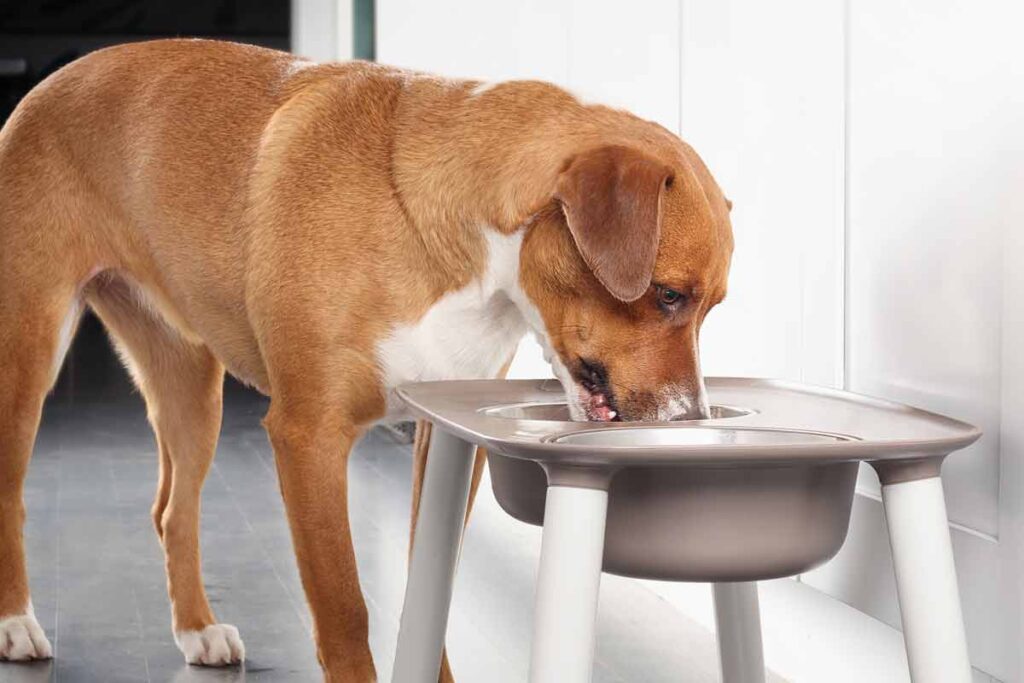There is not much worse than your doggy giving you those big puppy eyes when they want something. It’s the ultimate test of willpower. And, of course, it happens almost every time human food is around, making them excitedly drool. But understanding dog nutrition is critical to their health.
You may feel like sharing a bite of your pizza is not a bad idea, but there are possible immediate and long-term effects if you don’t feed your dog properly. Let this be your guide to doggy nutrition.
Table of Contents:
- Dog Nutrition 101
- Different Breeds and Sizes Require Different Diets
- What Should I Feed My Dog?
- What Shouldn’t I Feed My Dog?
- How Much Should I Feed My Dog?
- Monitoring Your Dog’s Response to Food
Dog Nutrition 101
Technically speaking, dogs are carnivores based on their tooth structure. Their teeth are designed to eat meat. But this doesn’t necessarily mean you should throw your dog a T-Bone. Just because a mammal is a carnivore, it doesn’t mean they can’t get their nutritional requirements through alternative means.
Dogs’ digestive tracts support diets that are primarily animal food and, in some cases, plants. Focusing on how easily a dog can digest something is sometimes as important as meeting their nutritional needs. Dogs also need a balanced diet like humans. They need minerals, vitamins, essential amino acids, fat, etc.
Different Breeds and Sizes Require Different Diets
Taking into account the size of your dog, the age of your pup, and the breed does matter. While there is some general nutrition advice we will get to, consider the following based on several factors.
- Puppies are growing dogs and will need more calories than older dogs. Supporting a healthy growing dog follows the same idea as a growing kid. Restricting their calories is not encouraged. They also have specialized puppy food that you can give them to meet their requirements until they are 12 months old or have reached adult size.
- Large dog breeds will need diets that have more calcium. Their calcium-to-phosphorus ratio is important as you need to support healthy bone structure.
- Toy dogs and small breeds require less food than their bigger furry friends. Avoiding overfeeding them is key to preventing dog obesity. It’s also important that their actual bite size is smaller so they don’t struggle to eat.
Keeping this in mind, let’s talk about general dog food ingredients and what to avoid.
What Should I Feed My Dog?
For some dogs, dry kibble or canned wet food is suitable. But this does not always give our playful pups the nutrition they need. And sometimes dogs don’t agree with certain brands.
- All commercial dog foods go through rigorous testing to make sure they have the minimal nutritional requirements for a dog. Choosing brands that offer above and beyond and high-quality ingredients of meats, grains, fruits, and vegetables is key. Some brands may meet minimum standards but it would be like giving your dog overall low quality fast food.
- You can add cooked meat (without flavors) and certain vegetables to a dog’s dish for direct nutrition. Veggies like carrots, beans, spinach, and other fibrous options are great. But some vegetables like garlic and onions are considered to be unsafe. Also, it’s important not to give raw meat to a dog as well as avoid giving any human food. This is both for processed and unprocessed. This can include types of dairy, some fruit, and so on.
- Always read the label. The FDA requires animal food to have several key pieces of information labels on the item for owners to be able to see. Something you should look for is the words “complete and balanced.” This isn’t any slogan. This is an indication that the product is meeting strict requirements.
When in doubt, it is important to consider speaking with a veterinarian who can help come up with a quality diet and nutritional plan for your dog based on its individual needs.
What Shouldn’t I Feed My Dog?
There is a lot of confusion and misinformation on the internet about what a dog can and can’t eat. Sometimes, we project human qualities onto our dogs, such as a gluten-free diet. It also is important never to force your dog to eat something. If you notice persistence and your dog refusing food, there is something likely underlying that a professional should check out.
Here are some common diets that need careful consideration.
Avoid Grain Free Diets
Grains are a very important nutrient source for dogs. While some dogs have developed allergies to certain foods, not every dog needs to be “gluten-free.” In fact, sometimes, if you choose a grain-free or pea diet, but it is not necessary, you end up having the opposite effect and reducing their nutrient intake.
Avoid Raw Meat Diets
Some dogs are able to consume raw meat. This became more of a trendy internet idea based on the assumption that cats’ and dogs’ ancestors ate raw meat. Consider it to be the paleo version sort-of-speak of dog diets.
Raw diets for dogs should be consulted about with a veterinarian. While offering more natural ingredients may be a positive, it is possible for dogs to ingest unsafe bacteria. A veterinarian nutritionist can help you weigh the advantages and disadvantages according to the needs of your pet.
How Much Should I Feed My Dog?
Dog obesity is a real concern in America. It’s becoming more of a common issue both from feeding dogs human food and from overfeeding our dogs. Many of our furry friends are always going to want more.
Helping them learn to wait patiently or not overeat is key. By reading the instructions on the back of the product. Each product has recommended feeding guidelines that are important to follow. It’s also critical to monitor and self-assess your dog’s weight.
If you struggle with this, your veterinarian will help. You should also consider asking a vet for help if you come across the opposite problem and your dog seems to have no appetite.
Monitoring Your Dog’s Response to Food
One of the most important things when it comes to your dog and its nutrition is to keep a watchful eye on them. If you notice that they are responding poorly to the food, it may be time to consider switching brands. If a poor response continues after switching brands, asking a professional veterinarian is important.
They may be able to help determine whether your dog has allergies or stomach sensitivities. Dogs’ digestive tracts are like humans in the way that they are unique, and not all dogs will be able to eat the same food. Giving your dog the quality nutrition they need personally is the best thing you can do.









